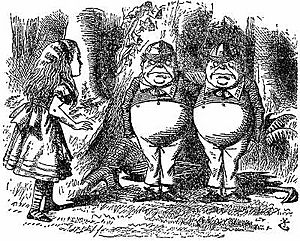Tweedledum and Tweedledee facts for kids
Quick facts for kids "Tweedledum and Tweedledee" |
|
|---|---|

John Tenniel's illustration, from Through the Looking-Glass (1871), chapter 4
|
|
| Nursery rhyme | |
| Published | 1805 |
Tweedledum and Tweedledee are characters in an English nursery rhyme and in Lewis Carroll's 1871 book Through the Looking-Glass, and What Alice Found There. Their names may have originally come from an epigram written by poet John Byrom. The nursery rhyme has a Roud Folk Song Index number of 19800. The names have since become synonymous in western popular culture slang for any two people who look and act in identical ways, generally in a derogatory context.
Lyrics
Common versions of the nursery rhyme include:
- Tweedledum and Tweedledee
- Agreed to have a battle;
- For Tweedledum said Tweedledee
- Had spoiled his nice new rattle.
- Just then flew down a monstrous crow,
- As black as a tar-barrel;
- Which frightened both the heroes so,
- They quite forgot their quarrel.
Origins
The words "Tweedle-dum and Tweedle-dee" make their first appearance in print as names applied to the composers George Frideric Handel and Giovanni Bononcini in "one of the most celebrated and most frequently quoted (and sometimes misquoted) epigrams", satirising disagreements between Handel and Bononcini, written by John Byrom (1692–1763): in his satire, from 1725.
- Some say, compar'd to Bononcini
- That Mynheer Handel's but a Ninny
- Others aver, that he to Handel
- Is scarcely fit to hold a Candle
- Strange all this Difference should be
- 'Twixt Tweedle-dum and Tweedle-dee!
Although Byrom is clearly the author of the epigram, the last two lines have also been attributed to Jonathan Swift and Alexander Pope. While the familiar form of the rhyme was not printed until around 1805, when it appeared in Original Ditties for the Nursery, it is possible that Byrom was drawing on an existing rhyme.
Through The Looking-Glass
The characters are perhaps best known from Lewis Carroll's Through the Looking-Glass and what Alice Found There (1871). Carroll, having introduced two fat little men named Tweedledum and Tweedledee, quotes the nursery rhyme, which the two brothers then go on to enact. They agree to have a battle, but never have one. When they see a monstrous black crow swooping down, they take to their heels. The Tweedle brothers never contradict each other, even when one of them, according to the rhyme, "agrees to have a battle". Rather, they complement each other's words, which led John Tenniel to portray them as twins in his illustrations for the book.
Other depictions
- In a 1921 letter to Harriet Shaw Weaver, the writer James Joyce uses the twins "Tweedledum and Tweedledee" to characterize Sigmund Freud and Carl Gustav Jung and their conflict.
- Helen Keller said of democracy in the US: "Our democracy is but a name. We vote? What does that mean? It means that we choose between two bodies of real, though not avowed, autocrats. We choose between Tweedledum and Tweedledee."
- Tweedledum and Tweedledee appear in the 1934 Betty Boop short film Betty in Blunderland using their clubs to battle only for them to duck their heads into their shirts and surrender.
- Tweedledum and Tweedledee appear in the 1951 version of Alice in Wonderland, voiced by J. Pat O'Malley, and representing the sun and moon as they tell Alice the story of The Walrus and the Carpenter. The Disney versions of the characters later appeared in the Disney television series House of Mouse and in the final scene of Who Framed Roger Rabbit.
- "Tweedle Dee & Tweedle Dum" is the opening song on Bob Dylan's 2001 album Love and Theft.
- Leading up to the 2010 United Kingdom general election, Tory leader David Cameron compared coalition-building British party leaders to "Tweedledum talking to Tweedledee, who is talking to Tweedledem."
- Tweedledum and Tweedledee appear in Once Upon a Time in Wonderland, portrayed by Ben Cotton and Matty Finochio. They appear as the Red Queen's servants where they started out working for the Red King. While Tweedledum is shown to be loyal to the Red Queen, Tweedledee is shown to be loyal to Jafar.
- Tweedledum and Tweedledee appear as minor antagonists in a few chapters of the game, The Wolf Among Us by Telltale Games.
- Tweedle Dee, Tweedle Dum is a song released in 1971 by british pop music band Middle of the road who reached Nr 2 in the UK charts.
See also
 In Spanish: Tweedledum y Tweedledee para niños
In Spanish: Tweedledum y Tweedledee para niños

